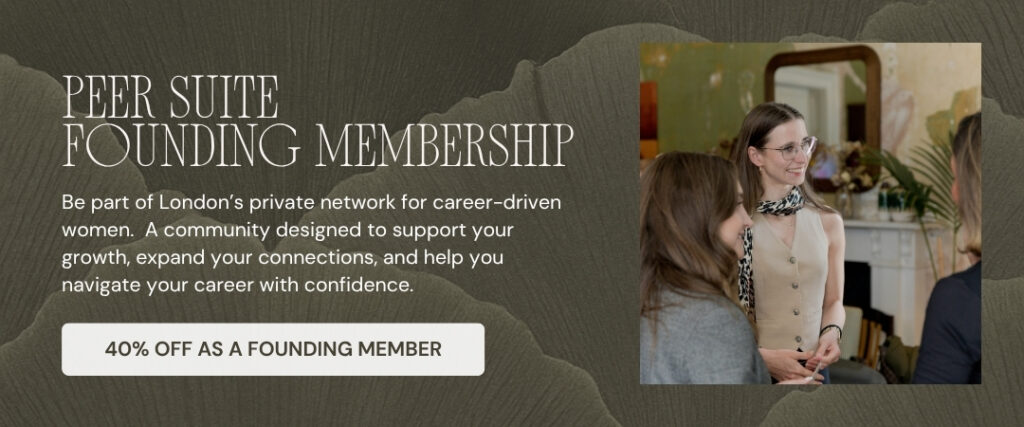December is a strange time for networking. Half your contacts are checked out, planning holidays, or rushing to finish year-end projects. The other half are at festive drinks, counting down to their time off, and definitely not thinking about work.
So should you even bother networking in December?
Actually, yes. December is one of the most underrated networking months of the year, precisely because most people aren’t doing it. There’s less noise, people are in a reflective mood, and you can strengthen relationships before the January rush when everyone’s inboxes explode with “Happy New Year, let’s catch up!” messages.
The trick is doing it well. December networking shouldn’t be about aggressively pushing your agenda at the Christmas party or sending generic “Happy Holidays” LinkedIn messages to 200 people. Instead it should be a time to strategically relationship-build in a relaxed way that sets you up for the year ahead.
Here’s how to stay visible, maintain your network, and position yourself for January opportunities without being the person who treats every social event like a job interview.
Contents
- Why December Networking Actually Matters
- The December Networking Mindset
- Holiday Party Networking (Without Being That Person)
- Year-End Check-Ins That Feel Natural
- LinkedIn Year-End Moves
- Setting Yourself Up for January Success
- The Thank You Strategy
- What NOT to Do in December Networking
- Networking When You’re Not Going to Holiday Parties
- Your December Networking Action Plan

Why December Networking Actually Matters
Before we get into the how, let’s talk about why this is worth your time.
People are reflective. December naturally invites looking back on the year. This makes people more open to meaningful conversations about what they’ve learned, what’s next, and who made a difference for them.
There’s less competition. Most people switch off from professional networking in December. If you’re strategic about it, you stand out simply by being present and thoughtful.
It sets you up for January. Hiring budgets refresh, new projects kick off, and people return with renewed energy. So the relationships you strengthen in December can become opportunities in January.
It’s relationship maintenance. You can’t ignore your network for 11 months and then suddenly reach out when you need something. December is a natural time to check in and stay connected.
It shows you’re strategic. People notice who maintains relationships during the “off season.” Staying engaged (without being pushy) demonstrates professionalism and genuine interest in people beyond what they can do for you.
The key is doing it authentically and making sure that your December networking is about strengthening relationships.
The December Networking Mindset
December networking is different from networking the rest of the year.
Focus on giving, not asking. This is not the time to request introductions, ask for job referrals, or pitch yourself for opportunities. December is about expressing gratitude, offering help, and nurturing relationships without expecting anything in return.
Be respectful of time and energy. Everyone is stretched thin in December. Keep interactions brief, low-pressure, and easy to respond to. Don’t send long emails that require thoughtful replies or ask for coffee chats during the busiest weeks of the year.
Think long-term. You’re not trying to “close a deal” in December. You’re planting seeds for relationships that will matter in the months and years ahead. Patience and authenticity will matter more than quick wins.
Quality over quantity. Don’t try to reach out to your entire network. Focus on the people who genuinely matter to you or who made a difference this year. Sending ten thoughtful customised messages is better than 100 generic ones.
With that mindset in place, here’s how to actually do it.

Holiday Party Networking (Without Being That Person)
Let’s start with the most obvious (and potentially awkward) scenario: the holiday party.
Whether it’s your company’s Christmas do, an industry event, or drinks with your professional network, holiday parties are tricky. You want to be visible and build relationships, but you don’t want to be the person treating it like a business development event.
Here’s what good holiday party networking looks like:
Actually enjoy yourself. If you’re only there to network, it shows. Be present, have fun, and treat it like a social event first. Authentic conversations are going to happen when you’re relaxed, not when you’re in “networking mode.”
Ask thoughtful questions about people’s year. Instead of launching into your accomplishments, ask others about theirs. “What was the highlight of your year?” or “What are you most proud of from this year?” are great conversation starters that feel natural and show genuine interest.
Listen more than you talk. The best networkers are brilliant listeners and when someone shares something they ask follow-up questions to show they are actually interested, not just waiting for their turn to speak.
Offer help where relevant. If someone mentions a challenge they’re facing and you can genuinely help (an introduction, a resource, advice), offer it. But only if it’s authentic and you’ll actually follow through with the offer. Write a reminder to yourself or a note in your calendar in the moment so you don’t forget.
Have conversations, not pitches. Your elevator pitch can stay at home. If someone asks what you do, answer naturally and then shift the conversation back to them.
And here’s what to avoid:
Don’t treat it like a job fair. Handing out business cards to everyone you meet and immediately connecting on LinkedIn, while very tempting, feels transactional. If you have a genuine connection with someone, exchange details naturally or connect afterwards with a personalised message referencing your conversation.
Don’t monopolise people’s time. If someone is clearly trying to move on or talk to others, let them go gracefully. You want to be memorable for being interesting, not for trapping them in a 20-minute monologue.
Don’t drink too much. This should be obvious, but it’s worth saying. One or two drinks to relax is fine, but losing your professionalism because you overdid it at the open bar is not.
The follow-up is where the real value happens. Within a day or two of the event, send a brief message to anyone you had a meaningful conversation with and reference something specific you discussed and express genuine interest in staying connected.

Year-End Check-Ins That Feel Natural
Holiday parties aren’t the only way to network in December. In fact, thoughtful one-to-one check-ins are often more valuable.
The goal is to reach out to people who mattered to you this year and let them know you appreciate them. The pupose is to acknowledge the role they played in your year and stay connected going into the next one.
Who to reach out to:
Start with people who directly helped you this year. Maybe a colleague who went above and beyond on a project, a mentor who gave you valuable advice, or a contact who made an introduction that led to an opportunity. These are the easy ones because you have a clear reason to reach out.
Then consider people you worked with but haven’t stayed in touch with. Former colleagues, clients, collaborators, or anyone you meant to follow up with but life got in the way. December is a natural reason to reconnect without it feeling forced.
Finally, think about people you’d like to strengthen relationships with in the new year. These might be newer connections, people in your industry you admire, or contacts you’d like to know better. A brief, genuine year-end message is a low-pressure way to stay on their radar.
How to reach out:
Keep your contact brief, two or three sentences is probaby enough. A short, genuine message is more likely to get read and responded to than a lengthy email.
Be specific about why you’re reaching out. Generic “Happy Holidays” messages get ignored. Instead, reference something specific. “I wanted to thank you for your advice on that presentation in June – it made a huge difference” or “I really enjoyed our conversation at the conference in October and wanted to check in.”
Don’t ask for anything, if your message ends with a request (coffee chat, introduction, advice), it feels transactional. Just express appreciation, share a quick update if relevant, and leave it there.
Wish them well for the holidays without being over the top. A simple “Wishing you a great break” or “Hope you have a restful end to the year” is enough.
Example messages:
“Hi Sarah, as the year wraps up, I wanted to thank you for connecting me with James back in March. That introduction led to the project I’m working on now, and I really appreciate you thinking of me. Wishing you a great break!”
“Hi Tom, I’ve been reflecting on this year and wanted to say thank you for your support during the rebrand project. Your feedback made such a difference to the final outcome. Hope you have a restful holiday!”
“Hi Emma, I came across your post about leadership challenges this week and it really resonated. We met briefly at the networking event in September, and I’d love to stay connected. Wishing you a great end to the year!”
These messages take two minutes to write and make a lasting impression because they’re specific, genuine, and don’t ask for anything.

LinkedIn Year-End Moves
LinkedIn is where a lot of December networking happens, for better or worse. Here’s how to use it strategically without contributing to the noise.
Update your profile while things are fresh. Before the year ends, update your experience section with projects you completed, skills you developed, and wins you achieved. Add quantifiable results where possible – “Led rebrand project that increased engagement by 40%” is more compelling than “worked on rebrand.”
Consider sharing a year-end reflection post (but only if it’s genuine). If you have something meaningful to share about what you learned this year, go for it.
Engage with others’ content thoughtfully. Instead of posting your own year-end roundup, comment on others’. Leave thoughtful, specific comments on posts from people in your network. This keeps you visible without needing to create your own content if you are not ready to do that.
Send personalised connection requests to people you met this year. If you attended events, met new colleagues, or were introduced to people through your network, connect with them on LinkedIn before the year ends. But personalise the message. “Great to meet you at the Women in Tech event in November – would love to stay connected” is far better than the generic connection request with no context.
Endorse or recommend people who helped you. This is an underrated way to strengthen relationships. Take five minutes to write a LinkedIn recommendation for someone who supported you this year, or endorse their skills. Most people don’t do this, so it stands out and feels genuinely generous.
Clean up your connections. Use December to review your LinkedIn network. Unfollow people whose content doesn’t add value and remove connections that aren’t relevant anymore.
Setting Yourself Up for January Success
Here’s where December networking pays off. While everyone else is scrambling to reconnect in January, you’re already ahead.
Schedule coffee chats for January now. Calendars fill up fast in January so if you reach out in mid-December to book time with people you want to connect with in the new year you are already ahead. “I’d love to catch up in January – does the second week work for you?” gives people time to plan and doesn’t add to their already busy December calendar.
Identify your networking priorities for next year. Who are the 5-10 people you want to strengthen relationships with? What communities or events do you want to engage with? What introductions would be valuable? Get clear on your networking strategy so you can be intentional rather than reactive.
Set up systems to stay in touch. If you’re serious about maintaining your network, you need a system. Add quarterly reminders to check in with key contacts. Use a spreadsheet or networking tracker to note when you last spoke to people and what to follow up on.
Join communities or groups you’ve been considering. If you’ve been thinking about joining a professional organisation, online community, or networking group like Peer Suite, January is when they’re most active. Research options in December so you’re ready to join when the new year starts.

The Thank You Strategy
Gratitude is the most underrated networking tool, especially in December. Taking the time to genuinely thank people who supported you this year strengthens relationships in a way that feels good for everyone involved.
Who to thank:
Think about anyone who made your year easier, better, or more successful. Your manager (if they genuinely supported you), colleagues who went above and beyond, clients or stakeholders you enjoyed working with, mentors who gave valuable advice, or people who opened doors for you.
How to thank them:
A handwritten note stands out in a digital world. If you have someone’s office address then make it more memorable by sending a card.
A thoughtful email works too, as long as it’s specific. “Thank you for everything this year” is forgettable. “Thank you for backing me on the presentation to the board in June – your confidence in me made all the difference” is powerful.
Small gifts can be appropriate if you have that kind of relationship and sending something thoughtful, not expensive is a great way to reconnect. A book you think they’d enjoy, coffee from their favourite place, or something related to a conversation you’ve had.
Public recognition matters. If someone went out of their way for you, acknowledge them publicly. A LinkedIn post thanking them, a shout-out in a team meeting, or mentioning them to senior leadership all count.
The most valuable thank you is offering to help them in return. “Let me know if there’s ever anything I can do for you” sounds empty. “I know you’re hiring in Q1 – I’m happy to share the role in my network” is specific and actionable.

What NOT to Do in December Networking
Let’s be clear about what bad December networking looks like so you can avoid it!
Don’t send mass “Happy Holidays” messages. If your message could be sent to 200 people without changing a word you probably want to rethink it. Sending something more personal will have greater impact if you have time to do that for all your contacts.
Don’t combine holiday greetings with asks. “Merry Christmas! By the way, are you hiring?” is terrible. Keep gratitude separate from requests. If you need something from someone, wait until January.
Don’t ghost people all year and suddenly reach out in December. If you haven’t spoken to someone since last Christmas, your “Happy Holidays” message feels hollow. Networking should be a year-round practice where you are nurturing relationships, not a December sprint.
Don’t over-promise coffee dates you won’t follow through on. Saying “Let’s grab coffee in January!” to 15 people and then never following up is worse than saying nothing. Only suggest it if you genuinely intend to make it happen.
Don’t network inappropriately. If you’re at a leaving drinks for a colleague, the focus should be on them, not your agenda. If you’re at a friend’s party where you happen to know some professional contacts, read the room because not every social situation is a networking opportunity.
Networking When You’re Not Going to Holiday Parties
Not everyone has access to (or wants to attend) holiday parties. Maybe you’re remote, introverted, not drinking, or just too burnt out for social events. Here’s how to network without them.
Virtual coffee chats work year-round. Schedule 30-minute video calls with people you want to stay connected with. December is actually a good time for this because people are working from home more and may have slightly more flexible schedules.
Written communication is underrated. A thoughtful email, LinkedIn message, or even a handwritten card can strengthen a relationship without requiring face-to-face interaction. Introverts often excel at written networking because they can be thoughtful and intentional.
Engage on LinkedIn from the comfort of your home. Comment on posts, share relevant content, send messages. Digital networking is still networking.
Small group activities feel less overwhelming than big parties. Suggest lunch with 2-3 people instead of attending a 50-person event. Smaller gatherings often lead to deeper conversations anyway.
Industry webinars and online events count. Attending a virtual panel discussion and engaging in the chat or following up with speakers afterwards is networking.

Your December Networking Action Plan
If this all feels overwhelming, here’s a simple checklist to make it manageable:
- Identify 10 people to reach out to before year-end – prioritise those who helped you most
- Send thank you messages to key supporters – colleagues, mentors, managers, clients
- Update your LinkedIn profile – add recent projects, skills, and achievements
- Schedule 3-5 January coffee chats – book them now before calendars fill up
- Attend at least one December event if you’re comfortable – or skip it entirely if you’re not
- Share one thoughtful piece of content on LinkedIn – comment on others’ posts if you don’t want to create your own
- Clean up your contact database – make sure you can actually find people when you need them
- Set quarterly reminders to check in with key contacts – make staying in touch a system that is easy for you to maintain
You don’t have to do all of this. Pick the 3-4 actions that feel most relevant to you and do them well.
Final Thoughts
December networking doesn’t need to mean you are everywhere, talking to everyone, and making sure every single person in your network knows you’re still around. Instead you should think about this as a time to be thoughtful and genuine in a way that strengthens the relationships that matter, while also setting yourself up for success in the new year.
Want to build a network that actually supports your career goals? Join the Peer Suite community to connect with professional women who are navigating the same challenges and building meaningful careers. Learn more about founding membership here.
Looking for more career strategies? Check out career moves you can make before year-end or learn how to finish the year strong.

22
Oct
